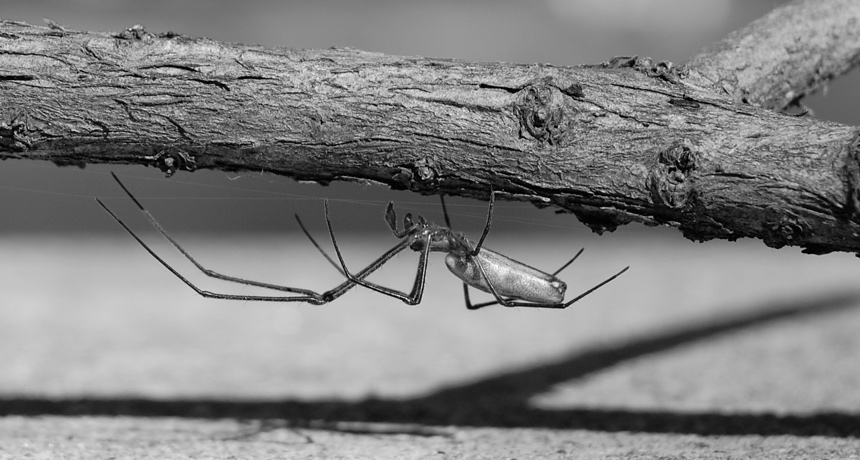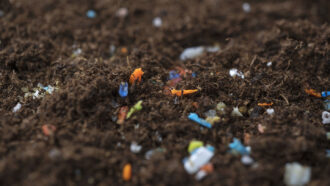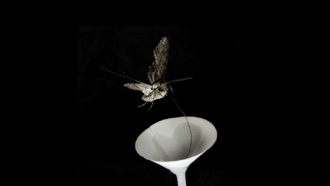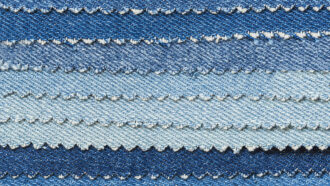Spidey sense: Eight-legged pollution monitors
Arachnids reveal chemical threats to food web

Spiders living along riverbanks, such as this long-jawed spider, can act as sentinels for toxic pollution. The eight-legged creatures can reveal the types, locations, amounts and even sources of chemicals polluting many rivers.
Ryan Otter
By Beth Mole
VANCOUVER — A magnifying glass can help detectives spy for clues. For environmental sleuths tracking water pollution, spiders living along riverbanks might work just about as well.
As spiders eat, their bodies will accumulate some of the chemicals polluting the environment. By measuring what taints their bodies, scientists can discover the types, locations, concentrations — and even potential risks — of water pollutants. Spiders may even give better results than the direct testing of a polluted river, researchers say. The experts reported their findings on November 11, here, at the annual meeting of the Society of Environmental Toxicology and Chemistry.
The chemicals in the study are called polychlorinated biphenyls, or PCBs. These chemicals are fairly harmless to insects and spiders. In people, PCBs can cause serious problems. The chemicals can interfere with our immune, reproductive and nervous systems. The United States banned PCBs in 1979. Before then, the chemicals were widely used in plastics, inks and electrical equipment.
PCBs remain a serious pollution problem. The compounds persist in the muck along the bottoms of many U.S. rivers, lakes and other waterways. It is hard to predict the threat that PCBs pose to animals and people based on sediment samples alone.
“That’s the big challenge,” explains Upal Ghosh. He’s an environmental engineer at the University of Maryland, Baltimore County. “If we take the sediment, that doesn’t quite tell what the harm is,” he notes. For instance, PCBs on a river bottom might stay put. However, they might also enter the food chain. Figuring out how much enters organisms that serve as food is pivotal to uncovering the risks that these chemicals pose to wildlife and people.
That is why spiders can be so useful. Midges and other insects can pick up PCBs from river muck during the early stages of their lives, when they spend time in the water. Spiders will later ingest the PCBs as part of their insect meals.
For spiders that dwell along riverbanks, every insect meal can up their accumulation of PCBs. This process is called biomagnification. The PCBs may not hurt the spiders. But anything that feeds on the spiders can, in turn, pick up those chemicals and carry them up the food chain, to birds, amphibians or the predators that eat these animals. But if scientists get to the spiders first, they measure their pollutant loads to learn more about what is tainting a particular river.
And that is exactly what a team of researchers led by David Walters did. Walters is an ecologist with the U.S. Geological Survey in Fort Collins, Colo. Between 2009 and 2013, his team collected almost 10,000 long-jawed and orb-weaving spiders. The eight-legged animals had been living along the Ottawa, Manistique and Ashtabula rivers. All three flow into the Great Lakes.
The team measured the pollutants carried by five to 20 spiders at each section along stretches of the rivers. They selected places known to be polluted with PCBs and other chemicals. For each site, the experts identified the type of PCBs in spiders and the amounts tainting these arachnids. The team also calculated the risk those polluted spiders might pose to nearby predators. Using spiders to unravel that threat, Ghosh says, is intriguing.
PCB levels in the two species of spiders were high enough to pose a risk to other wildlife, including birds, Walters says. These findings may partly explain the decline in some songbird populations, he says. The PCB levels also mirror those seen in some fish, which could pose health risks to people. Signs posted in places along all three rivers recommend people limit or avoid eating certain species of fish living there.
The researchers used the mix of chemicals found in certain spiders to pinpoint pollution sources. For instance, spiders living downstream from a paper-recycling plant on the Manistique River contained the same mix of PCBs used in paper recycling.
Walters hopes that the spider monitoring could help keep tabs on polluted sites. It might also track how well river clean-ups work; these projects can cost millions of dollars. Using spiders as sentinels might even uncover new pollution hot spots.In fact, other researchers across the United States are already starting to do just that.
Power Words
arachnid A group of invertebrate animals that includes spiders, scorpions, mites and ticks. Many have silk or poison glands.
biomagnification The process by which the concentration of a chemical increases as it moves up the food chain. Typically, this occurs when a predator species feeds upon prey contaminated with that chemical.
immune system The collection of cells and their responses that help the body fight off infection.
midges Any of many types of small flies that often live around water. Some are blood-sucking insects; others can derive their energy from eating plants. Frequently mistaken for mosquitoes, midges can transmit disease or move pollutants through an ecosystem.
nervous system The network of nerve cells and fibers that transmits signals between parts of the body.
pollutant A substance that taints something — such as the air, water, our bodies or products. Some pollutants are chemicals, such as pesticides. Others may be radiation, including excess heat or light. Even weeds and other invasive species can be considered a type of biological pollution.
polychlorinated biphenyls A family of 209 chlorine-based compounds with a similar chemical structure. They were used for many decades as a nonflammable fluid for insulating electrical transforms. Some companies also used them in making certain hydraulic fluids, lubricants and inks. Their production has been banned in North America and many countries throughout the world since around 1980.
predator (adjective: predatory) A creature that preys on other animals for most or all of its food.
prey Animal species eaten by others.
sediment Material (such as stones and sand) deposited by water, wind or glaciers.
toxic Poisonous or able to harm or kill cells, tissues or whole organisms. The measure of risk posed by such a poison is its toxicity.







